Content for TS 23.081 Word version: 18.0.0
2 Calling line identification restriction (CLIR)
2.1 Handling of calling line identification restriction
2.1.1 General
2.1.2 Permanent mode
2.1.3 Controlling presentation of the CLI when CLIR is provisioned in temporary mode
2.1.4 Interrogation
2.2 Functions and information flows
2.3 Information stored in the HLR
2.4 State transition model
2.5 Transfer of information from HLR to VLR
2.6 Information stored in the VLR
2.7 Handover
2.8 Interworking
...
...
2 Calling line identification restriction (CLIR) p. 23
2.1 Handling of calling line identification restriction p. 23
2.1.1 General p. 23
If the originating party has calling line identification restriction provisioned and it is impossible to indicate to the terminating network (due to interworking) that the number should not be presented to the terminating party, the calling line identity shall not be delivered to the terminating network.
2.1.2 Permanent mode p. 23
If the subscriber has calling line identification restriction provisioned in permanent mode, the originating party's CLI shall not be presented to the terminating party (i.e. the terminating MS or TE), unless the terminating party has calling line identification presentation provisioned with the subscription option "override category" set (see clause 1).
2.1.3 Controlling presentation of the CLI when CLIR is provisioned in temporary mode p. 23
A subscriber can have calling line identification restriction provisioned in temporary mode with one of two default values: presentation restricted or presentation allowed.
If the default value is set to presentation restricted, the default handling is not to present the originating party's CLI to the terminating party (i.e. the terminating MS or TE).
However, it is possible for the originating subscriber to present his CLI to the terminating party. The originating subscriber must indicate during call set up that the CLI must be presented to the terminating party. This procedure is illustrated in Figure 2.1.

Figure 2.1: MS indicating presentation of CLI when CLIR is provisioned in temporary mode with default value "presentation restricted"
(⇒ copy of original 3GPP image)
(⇒ copy of original 3GPP image)
If the default value is set to presentation allowed, the default handling is to present the originating party's CLI to the terminating party (i.e. the terminating MS or TE).
However, it is possible for the originating subscriber to restrict presentation of his CLI to the terminating party. The originating subscriber must indicate during call set up that CLI presentation must be restricted. This procedure is illustrated in Figure 2.2.

Figure 2.2: MS invoking CLIR, when CLIR is provisioned in temporary mode with default value "presentation allowed"
(⇒ copy of original 3GPP image)
(⇒ copy of original 3GPP image)
2.1.4 Interrogation p. 24
Data request
The mobile subscriber can request the data of the supplementary service.
In response the following information shall be given:
- whether the service is provided or not;
- if provided which mode is subscribed;
- if subscribed to the temporary mode: which default value.

Figure 2.3: Interrogation of calling line identification restriction
(⇒ copy of original 3GPP image)
(⇒ copy of original 3GPP image)
2.2 Functions and information flows p. 24
The following Mobile Additional Functions have been identified for the PLMN:
MAF003
The information flows are shown in Figure 2.6 to Figure 2.9.
Determination of the calling line identification restriction subscription
The ability of a PLMN component to determine whether the supplementary service is provisioned for the mobile subscriber. See Figure 2.4.
Location: VLR.
MAF004
Determination of the calling party number for offering to the called party
The ability of a PLMN component to determine and to forward the calling line identity and related indications to the called party. See Figure 2.5.
Location: originating MSC.
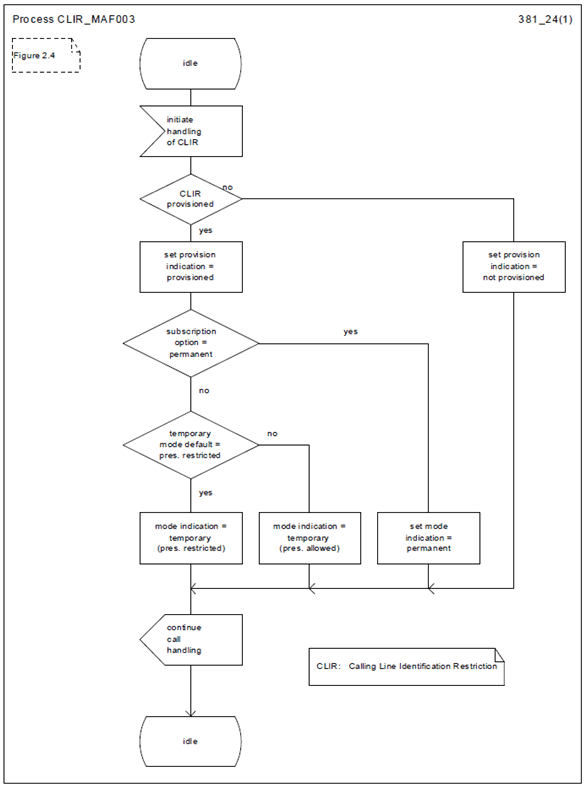
Figure 2.4: MAF003 Determination of calling line identification restriction subscription (VLR)
(⇒ copy of original 3GPP image)
(⇒ copy of original 3GPP image)
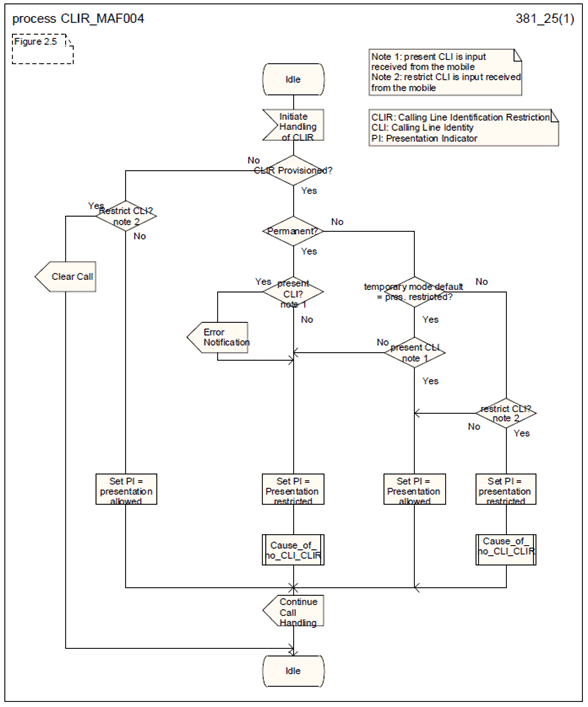
Figure 2.5: MAF004 Determination of the presentation indicator (originating MSC)
(⇒ copy of original 3GPP image)
(⇒ copy of original 3GPP image)
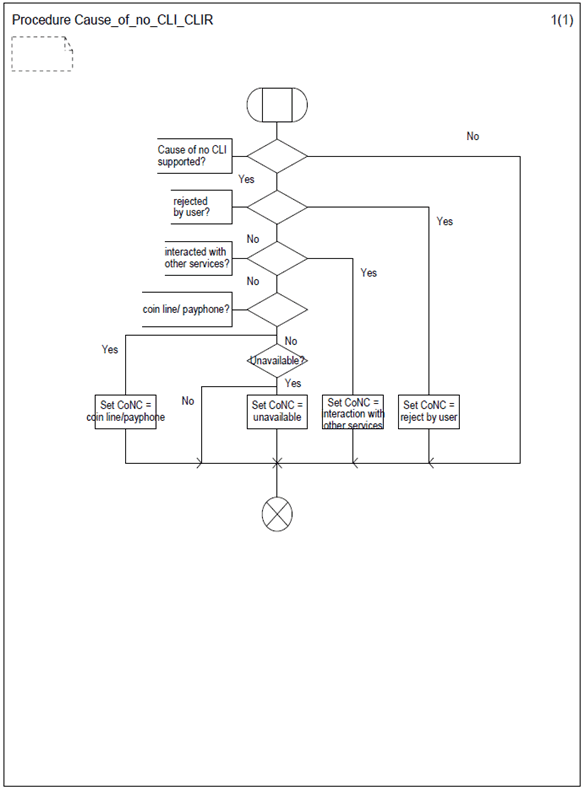
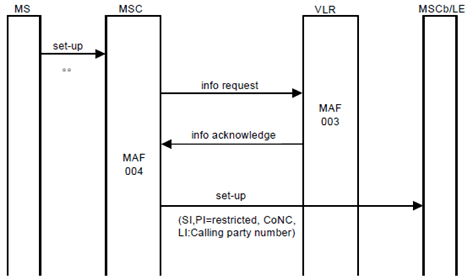
Figure 2.7: Information flow for calling line identification restriction in permanent or temporary mode with the default value "presentation restricted"
(⇒ copy of original 3GPP image)
(⇒ copy of original 3GPP image)
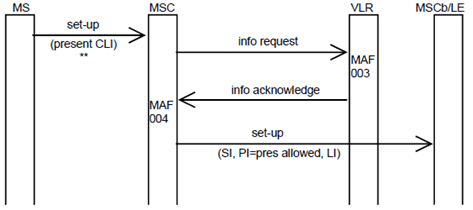
Figure 2.8: Information flow for allowing presentation of the CLI when CLIR is provisioned in temporary mode with default value ""presentation restricted"
(⇒ copy of original 3GPP image)
(⇒ copy of original 3GPP image)
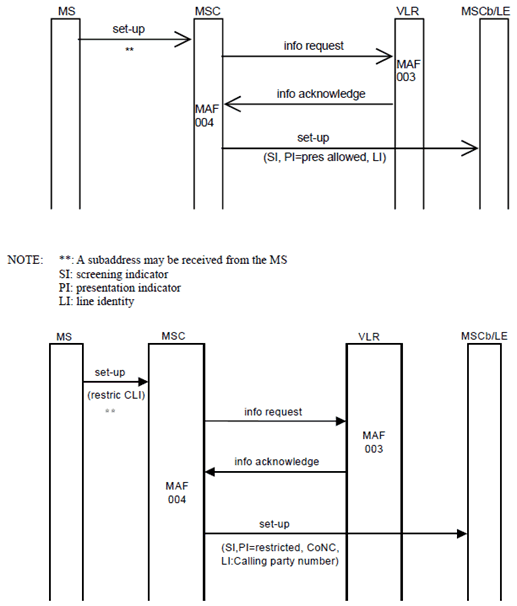
Figure 2.9: Information flow for calling line identification restriction in temporary mode with default value "presentation allowed"
(⇒ copy of original 3GPP image)
(⇒ copy of original 3GPP image)
2.3 Information stored in the HLR p. 31
CLIR may have the following logical states (refer to TS 23.011 for an explanation of the notation):
| Provisioning State | Registration State | Activation State | HLR Induction State |
|---|---|---|---|
| (Not Provisioned, | Not Applicable, | Not Active, | Not Induced) |
| (Provisioned, | Not Applicable, | Active and Operative, | Not Induced) |
The HLR shall store the logical state of CLIR (which shall be one of the valid states listed above) on a per subscriber basis.
The HLR shall also store the subscription option "presentation mode" on a per subscriber basis.
This parameter takes one of the following values:
- permanent;
- temporary (presentation restricted);
- temporary (presentation allowed).
2.4 State transition model p. 31
The following Figure shows the successful cases of transition between the applicable logical states of CLIR. The state changes are caused by actions of the service provider.
Note that error cases are not shown in the diagram as they normally do not cause a state change. Additionally, some successful requests may not cause a state change. Hence they are not shown in the diagram.
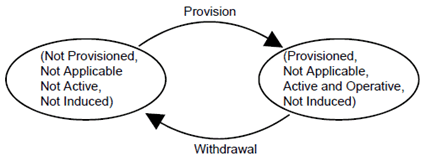
2.5 Transfer of information from HLR to VLR p. 31
When the subscriber registers on a VLR, the HLR shall send that VLR information about the logical state of CLIR and the presentation mode.
If the logical state of CLIR or the presentation mode is changed while a subscriber is registered on a VLR then the HLR shall inform the VLR of the new logical state of CLIR and (if the provisioning state is "Provisioned") the new presentation mode.
2.6 Information stored in the VLR p. 31
For CLIR, the VLR shall store the service state information and presentation mode received from the HLR.
2.7 Handover p. 32
Handover will have no impact on the control procedures and the operation of the service.
2.8 Interworking p. 32
The VPLMN needs to distinguish three cases in order to meet data privacy requirements in an environment where support of CLIP and CLIR is optional:
- the HPLMN supports CLIR, and CLIR is provisioned for the subscriber;
- the HPLMN supports CLIR, but CLIR is not provisioned for the subscriber;
- the HPLMN does not support CLIR.
- If the HLR supports CLIR, but CLIR is not provisioned for the subscriber, the HLR shall inform the VLR that CLIR is not provisioned.
- If the VLR supports CLIR, but the HLR does not support CLIR, the VLR shall behave in the same way as if CLIR (temporary (presentation restricted)) was provisioned for the subscriber, i.e. the calling line identity shall not be displayed to the called subscriber unless the called subscriber has CLIR override capability. When interrogating the service status the subscriber shall be informed that CLIR (temporary (presentation restricted)) is provided to him and is active.